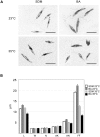Leptomonas seymouri: Adaptations to the Dixenous Life Cycle Analyzed by Genome Sequencing, Transcriptome Profiling and Co-infection with Leishmania donovani
- PMID: 26317207
- PMCID: PMC4552786
- DOI: 10.1371/journal.ppat.1005127
Leptomonas seymouri: Adaptations to the Dixenous Life Cycle Analyzed by Genome Sequencing, Transcriptome Profiling and Co-infection with Leishmania donovani
Abstract
The co-infection cases involving dixenous Leishmania spp. (mostly of the L. donovani complex) and presumably monoxenous trypanosomatids in immunocompromised mammalian hosts including humans are well documented. The main opportunistic parasite has been identified as Leptomonas seymouri of the sub-family Leishmaniinae. The molecular mechanisms allowing a parasite of insects to withstand elevated temperature and substantially different conditions of vertebrate tissues are not understood. Here we demonstrate that L. seymouri is well adapted for the environment of the warm-blooded host. We sequenced the genome and compared the whole transcriptome profiles of this species cultivated at low and high temperatures (mimicking the vector and the vertebrate host, respectively) and identified genes and pathways differentially expressed under these experimental conditions. Moreover, Leptomonas seymouri was found to persist for several days in two species of Phlebotomus spp. implicated in Leishmania donovani transmission. Despite of all these adaptations, L. seymouri remains a predominantly monoxenous species not capable of infecting vertebrate cells under normal conditions.
Conflict of interest statement
The authors have declared that no competing interests exist.
Figures





References
-
- Podlipaev SA (2001) The more insect trypanosomatids under study-the more diverse Trypanosomatidae appears. Int J Parasitol 31: 648–652. - PubMed
-
- Simpson AG, Stevens JR, Lukeš J (2006) The evolution and diversity of kinetoplastid flagellates. Trends Parasitol 22: 168–174. - PubMed
-
- Laveran A, Franchini G (1920) Infections experimentales de chiens et de cobayes a l'aide de cultures d'Herpetomonas d'insects. Bull Soc Pathol Exot 13: 569–576.
Publication types
MeSH terms
LinkOut - more resources
Full Text Sources
Other Literature Sources
Molecular Biology Databases
Miscellaneous

